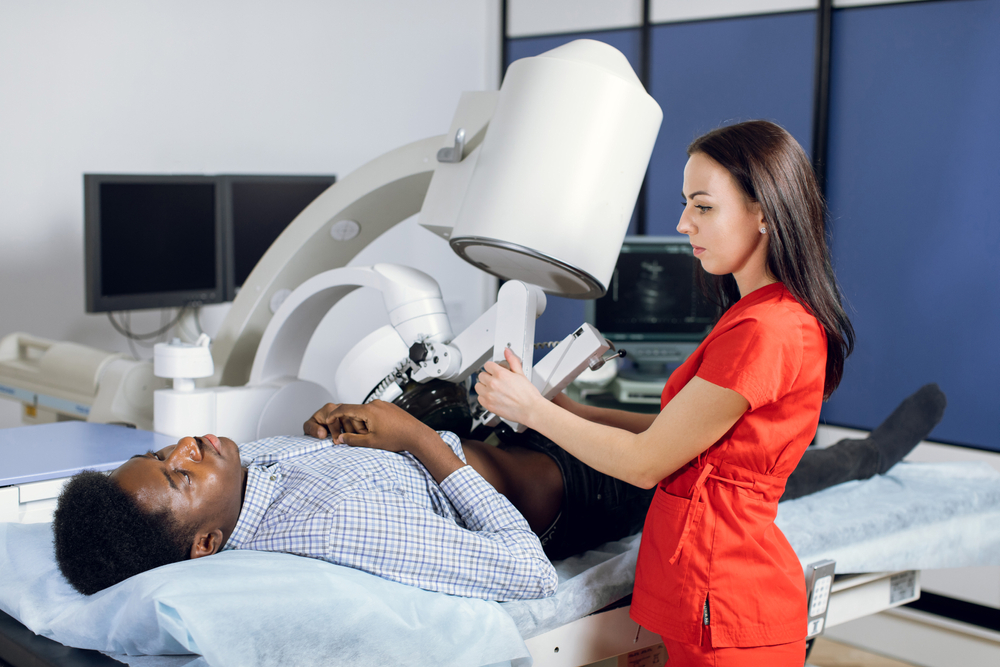Shockwave lithotripsy is an innovative treatment for Peripheral arterial disease (PAD). PAD is a condition affecting millions worldwide that can lead to serious complications from narrowed or blocked arteries due to plaque buildup. This narrowing reduces blood flow, causing pain, numbness, weakness, and potentially severe tissue damage.
Traditional treatments for PAD, such as stents and balloons, often struggle with calcified arteries. Calcification makes arteries stiff, complicating balloon angioplasty and increasing the risk of complications. This stiffness can make proper stent placement difficult, leading to unsuccessful treatments and recurring symptoms, which may need more invasive surgeries.
What Is Shockwave Lithotripsy?
Shockwave intravascular lithotripsy (shockwave IVL) uses sonic pressure waves to break down calcified plaque in arteries. Unlike conventional methods, this technique preserves healthy tissue and minimizes the risk of plaque fragments traveling downstream. Shockwave lithotripsy improves the effectiveness of traditional treatments by making arterial walls more flexible.
This minimally invasive approach builds on principles used in kidney stone treatment for many years and represents a significant advancement in vascular medicine. It improves treatment outcomes and reduces the need for invasive procedures, offering new hope for patients with complex arterial conditions.
How Does It Work?
The shockwave intravascular lithotripsy procedure consists of several key steps:
- Anesthesia: Most patients receive local anesthesia and remain awake during the procedure.
- Catheter insertion: A specialized catheter, a thin, flexible tube with small devices called lithotripsy emitters, is carefully guided through the blood vessel to the area where calcium has built up. This catheter is designed to be flexible, allowing physicians to navigate it through the complex pathways of the vascular system.
- Generating sonic waves: Once the catheter is in place, the system produces sonic pressure waves. These waves travel through the soft tissue of the arteries without causing any harm. They are specifically adjusted to effectively target calcium deposits while minimizing any impact on the surrounding healthy tissue.
- Breaking down calcium deposits: When these sonic waves reach hardened calcium deposits, they create tiny fractures in the calcium. This process breaks down the deposits while keeping the underlying structure of the artery intact. It’s similar to how sound waves can break glass without affecting nearby objects.
- Improving artery flexibility: This treatment helps make the artery more flexible by breaking down the calcium. This increased flexibility allows for better blood flow and enhances the effectiveness of other treatments, such as stenting or angioplasty, which are often used to open up narrowed arteries.
- Guided procedure: Throughout the entire procedure, advanced imaging techniques are used to help guide the physician. This ensures that the shock waves are delivered precisely to the targeted areas.
The unique aspect of shockwave therapy for blocked arteries is its ability to selectively target only the calcium deposits. Unlike traditional treatments that might risk damaging the arterial walls or dislodging plaque fragments, shockwave IVL offers a more controlled and safer approach.
Who Is a Candidate for Shockwave Lithotripsy?
Shockwave lithotripsy is an effective treatment option for several types of patients. Ideal candidates typically include:
- Patients with severe arterial calcification that makes traditional treatments difficult.
- Those who have not responded well to conventional treatments.
- Patients seeking minimally invasive alternatives to open surgery.
- Patients with complex arterial disease patterns that require precise treatment.
- Those with multiple risk factors who may not be suitable for more invasive procedures.
Your physician will conduct a thorough evaluation to determine if shockwave IVL is right for you. This assessment includes reviewing your medical history, calcification amount, overall health status, and previous treatments. Imaging studies will determine the location and severity of calcium deposits.
Certain conditions may make some patients more suitable candidates than others. For example, people with extensive calcification across multiple vessels might benefit from this treatment because it can effectively address multiple areas in a single procedure.
Regular vascular health check-ups are especially important for individuals with risk factors for PAD, such as:
- Smoking
- High cholesterol
- High blood pressure
- Previous history of a heart attack and stroke
- Diabetes
- Age above 60
- Obesity

Benefits of Shockwave Lithotripsy for Artery Health
The benefits of intravascular lithotripsy make it a popular choice among vascular specialists. Here’s a breakdown of its key advantages:
Minimal Tissue Damage
Shockwave lithotripsy uses sonic pressure waves that specifically target calcified areas in the arteries. This means it can break down harmful deposits without harming the surrounding healthy tissue. By preserving the integrity of the arterial walls, this approach reduces the risk of complications and is crucial for maintaining long-term vessel health.
Enhanced Treatment Success
One of the significant advantages of shockwave IVL is its ability to effectively break down calcium deposits. This leads to better outcomes in subsequent treatments, such as stenting. When the calcium is removed, the walls of the arteries can expand more easily, allowing stents to fit better and work more effectively.
Reduced Procedural Risks
The controlled nature of shockwave lithotripsy minimizes the chances of plaque fragments breaking loose during treatment. This is especially important when dealing with complex lesions, where traditional methods might pose higher risks. By preventing these fragments from moving downstream, shockwave IVL helps avoid potential complications.
Faster Recovery
Because shockwave lithotripsy is a minimally invasive procedure, patients often experience shorter recovery times compared to traditional surgeries. Many individuals can return to normal activities within just a few days after the procedure, making it a convenient option for those needing treatment.
Better Long-Term Outcomes
By effectively treating calcification in the arteries, shockwave IVL can lead to more durable results and a reduced need for repeat procedures. Properly modifying calcium deposits helps create a more stable environment within the blood vessels, promoting better long-term health.
Versatility
This technology is versatile and can be used in various parts of the body. It can also be combined with other treatment methods when necessary, providing flexibility in how doctors plan and execute treatment for their patients.
Shockwave lithotripsy offers numerous benefits that enhance patient care and improve treatment outcomes for arterial calcification patients.
Are There Any Risks with Shockwave Lithotripsy?
While shockwave lithotripsy is generally safe, there are some risks to consider. These may include minor discomfort during the procedure, temporary swelling, or bruising at the catheter site. In rare cases, the treatment might be less effective for certain calcifications or advanced arterial disease. Your physician will carefully evaluate these factors to determine if this procedure is right for you.
When to Consult a Doctor
It’s important to seek medical attention if you experience symptoms that might indicate peripheral arterial disease or other vascular conditions. These symptoms include:
- Leg pain or cramping during physical activity
- Numbness or weakness in the legs
- Slow-healing wounds on feet or legs
- Color changes in the feet
- Lower temperature in one leg compared to the other
- Diminished pulse in the legs or feet
- Unexplained leg fatigue or heaviness
- Changes in toenail thickness or growth
- Hair loss on feet and legs
Early intervention with treatments like shockwave IVL can help prevent disease progression and reduce the need for more invasive procedures in the future. Regular vascular health screenings can help identify problems before they become severe.
Shockwave IVL technology is an important step forward in treating arterial calcification. By providing a safer, more effective option for dealing with calcified plaque, this innovative approach is helping patients avoid more invasive surgical procedures. The technology continues to evolve, with ongoing research and development leading to improved devices and techniques that may further enhance treatment success rates.
As with any medical procedure, success rates are highest when treatment begins early. This makes speaking with your physician about any vascular health concerns crucial. Combining early detection and appropriate intervention with technologies like shockwave IVL and managing risk factors is the best way to keep your vascular system healthy.
At Empire Vein & Vascular Specialists, we are dedicated to offering advanced treatments like shockwave lithotripsy to help restore your health and enhance your quality of life. Our skilled team of board-certified vascular specialists, including interventional radiologists, utilizes the latest technology to provide personalized care tailored to your needs.
Whether you are facing peripheral arterial disease, varicose veins, spider veins, or arterial calcification, we are here to support you every step of the way. Empire Vein is the nation’s largest provider of VenaSeal™ varicose vein treatment and offers a wide range of vascular services in Southern California. We accept most insurances, including Medicare, most PPOs and HMOs, and IEHP.
Take control of your vascular health. Schedule a consultation today to learn how shockwave lithotripsy could be an effective treatment option for you.
Call us now at 1-800-827-4267 or visit our website to book an appointment.

